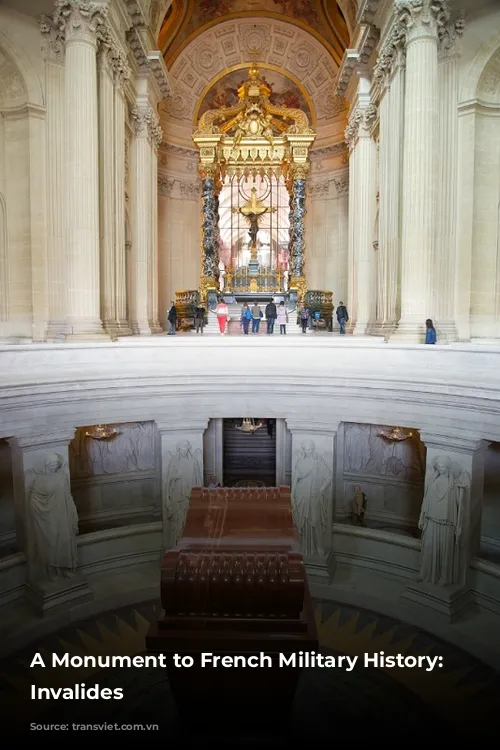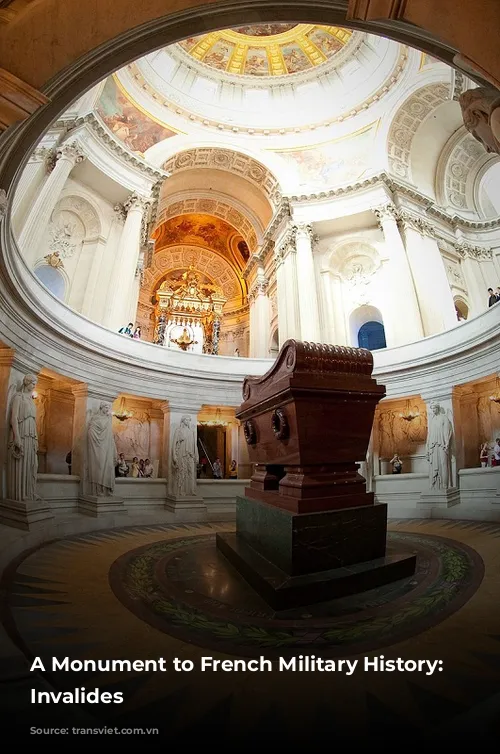Stepping into a world of grandeur and history, Les Invalides in Paris holds a special place in the hearts of many. This iconic complex houses more than just a stunning monument, but also a testament to France’s rich military heritage.

A Palace for Veterans and a Shrine for Military Glory
At the heart of Paris, in the 7th arrondissement, stands Les Invalides, a sprawling complex that blends history, architecture, and military might. It’s more than just a building; it’s a monument to France’s military past. It serves as a reminder of the nation’s valor and the sacrifices made by its soldiers.
This complex, built by order of King Louis XIV in the 17th century, was originally conceived as a hospital and retirement home for wounded soldiers. The construction, starting in 1670 and completed in 1676, provided much-needed care and accommodation for those who had served their country.
Les Invalides is comprised of the majestic Hôtel des Invalides, a sprawling building encompassing various museums and exhibition spaces, along with the Esplanade des Invalides, a sprawling park offering peaceful green space. It’s a sight to behold, a masterpiece of architectural splendor that reflects the grandeur of the French monarchy.
The complex boasts numerous museums, including the Musée de l’Armée, dedicated to showcasing the French army’s history, the Musée des Plans-Reliefs, housing impressive military models, and the Musée d’Histoire Contemporaine, offering insight into contemporary history.
Adding to its grandeur, the Église du Dôme (Church of the Dome) stands as a separate royal chapel, constructed to glorify both the monarchy and the military. It’s a testament to the enduring influence of the French military tradition.

Napoleon’s Final Resting Place: The Dôme des Invalides
Over time, Les Invalides evolved into more than just a hospital and retirement home; it became a mausoleum, a place to honor France’s military heroes. Under the reign of Napoleon I, the Dôme des Invalides transformed into a shrine, showcasing the remains of distinguished figures like Aiglon, the Bonaparte brothers Joseph and Jérôme, and renowned generals like Bertrand, Duroc, Foch, and Lyautey.
The Dôme des Invalides itself is an architectural marvel, its golden dome rising high above the Parisian skyline. It’s a beacon of French military glory, visible from afar.
In 1842, the Dôme underwent extensive renovations, which included the construction of a special resting place for Emperor Napoleon I. His remains were finally laid to rest within the Dôme in 1861, creating a permanent tribute to the controversial figure who shaped France’s destiny.

The Tomb of a Legend: A Journey Through History
The Dôme’s interior is a treasure trove of art and history. Nestled beneath the golden dome, on the second floor, lies the tomb of Napoleon Bonaparte.
The entrance to the tomb is adorned with two bronze doors, engraved with Napoleon’s poignant last words. As you step inside, your eyes are drawn to twelve female statues, representing the twelve military victories that marked Napoleon’s reign. The walls are adorned with 10 bas-reliefs, narrating the French emperor’s exploits and highlighting his military prowess.
At the heart of the circular tomb, surrounded by colorful stained glass, rests Napoleon’s coffin. It’s a poignant reminder of the man who once led France to glory. The coffin, crafted from various materials like iron, mahogany, lead, ebony, and oak, rests on a red sandstone sarcophagus, placed on a green granite base. Beneath the sarcophagus, a marble floor is decorated with a laurel wreath and inscriptions commemorating Napoleon’s eight major victories.

Visiting Les Invalides: A Journey Through Time
Les Invalides is open to the public and offers a glimpse into the heart of French military history. A single entrance ticket, costing €9.50 for adults, grants access to both the Dôme des Invalides and the Musée de l’Armée. Children are granted free entry to the complex. The opening hours are from 10:00 AM to 6:00 PM from April 1st to October 31st, and from 10:00 AM to 5:00 PM from November 1st to March 31st.
The complex can be accessed from various directions depending on your preferred mode of transportation.
Aside from Napoleon’s tomb, the complex offers a wealth of other attractions, including museums, exhibitions, and more. It’s a truly immersive experience, a journey back in time, and a must-visit destination for anyone interested in history, art, or the spirit of France.










